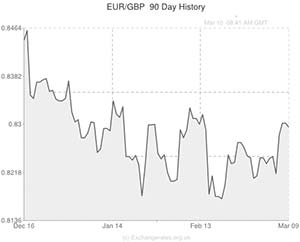
The UK’s economic outlook may be positive, with domestic data releases pointing to a broad-based recovery, but the Pound is still trading lower against a bullish Euro.
Last week the common currency rallied against its peers and advanced on the Pound as the European Central Bank refrained from introducing additional stimulus and positively revised its growth forecasts for the Eurozone.
The common currency subsequently achieved a 2 ½ year high against the US Dollar and was barely affected by the upbeat US non-farms payrolls figure.
The Euro largely held these gains over the weekend even as Ukraine tensions drove investors towards lower-risk assets.
During local trading on Monday, the Euro extended gains against the Pound and ‘Greenback’ as the Sentix investor confidence measure for the Eurozone achieved a 35 month high.
The sentiment gauge advanced from 13.3 in February to 13.9 in March, the best reading since April 2011 and only slightly short of the reading of 14.0 forecast by economists.
In a statement published with the figure Sentix commented; the ‘economic index (composite index) for the euro zone rises again in March and climbs from 13.3 to 13.9 points. This development is driven by investors’ assessments of the current situation, while 6-month expectations fall for the first time since September. For Germany, expectations decline for the third month in a row. Nevertheless, the composite index still signals that the German economy is in the middle of boom.’
It was also said that; ‘In the rest of the world things look rather mixed: Against the background of the Crimean crisis the sentix eco-nomic index for Eastern Europe drops strongly. But it rises for the two other emerging-markets regions, Asia ex Japan and Latin America. For the US, investors’ opinions remain almost unchanged, while for Japan sentiment worsens further. The composite index for the global aggregate stays at a constant level, but the relatively high heterogeneity between countries and regions points to an increased uncertainty among investors and blurs the overall picture.’
The EUR/GBP pairing didn’t respond to the UK Lloyds employment confidence report, which was unchanged in February at -2.
As the week progresses a whole stream of influential economic reports for the Eurozone are likely to have an impact on the Euro’s exchange rate.
Tomorrow German trade data and Italian growth figures will be of particular interest.
On Wednesday Euro movement could be occasioned by industrial production figures for the 18-nation currency bloc.
On Thursday the publication of the European Central Bank’s monthly report is the day’s big European news, while Euro movement on Friday may be occasioned by German inflation figures.
Elsewhere, currency market volatility could be triggered by Ukraine developments, US retail sales data and UK growth/trade figures.
Euro Exchange Rates
[table width=”100%” colwidth=”50|50|50|50|50″ colalign=”left|left|left|left|left”]
Currency, ,Currency,Rate ,
Euro, ,Pound Sterling,0.8326,
,Pound Sterling,0.8326,
Euro, ,US Dollar,1.3891,
,US Dollar,1.3891,
Euro, ,Canadian Dollar,1.5431,
,Canadian Dollar,1.5431,
Euro, ,Australian Dollar,1.5346,
,Australian Dollar,1.5346,
Euro, ,New Zealand Dollar,1.6420 ,
,New Zealand Dollar,1.6420 ,
US Dollar, ,Euro ,0.7199,
,Euro ,0.7199,
Pound Sterling, ,Euro,1.2011,
,Euro,1.2011,
Canadian Dollar, ,Euro,0.6478,
,Euro,0.6478,
Australian Dollar, ,Euro,0.6514,
,Euro,0.6514,
New Zealand Dollar, ,Euro,0.6096 ,
,Euro,0.6096 ,
[/table]

Comments are closed.